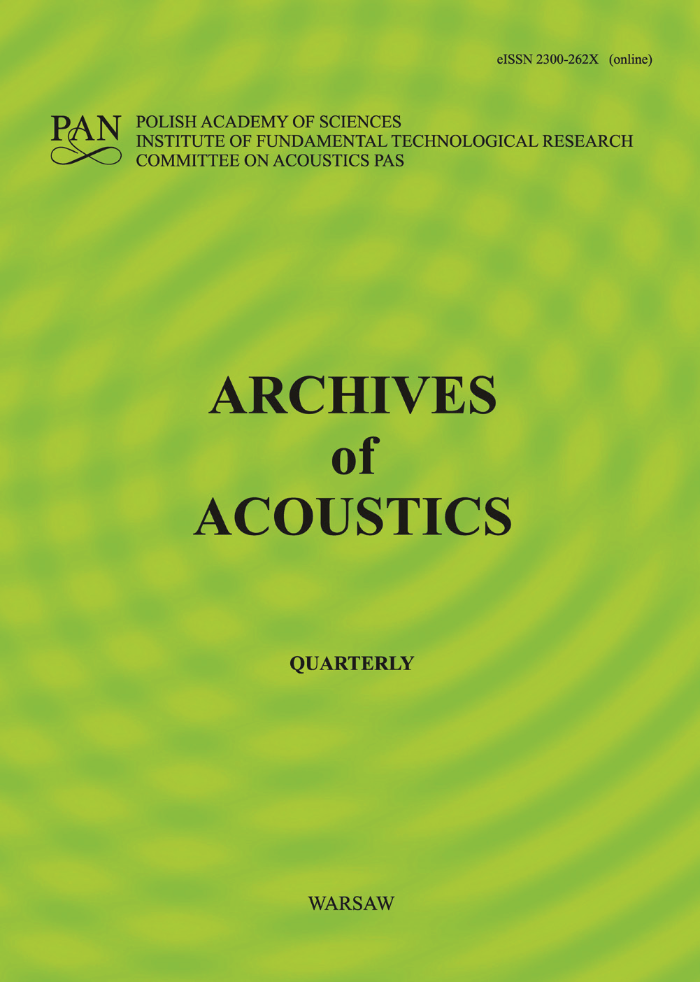Mapping Sound Pressure Levels: A Novel Approach to Determining Near-field and Far-field Regions
Abstract
The present study focuses on the spatial characteristics of the sound pressure level (SPL) generated by a circular piston (a circular-shaped acoustic transducer or loudspeaker). It presents a short theoretical review to aid in understanding the primary sound field characteristic – acoustic pressure – as a function of time, frequency, directivity angle, and distance from the source. The study introduces a simple and practical criterion for determining the near- and far-field boundary along the axis of the circular piston as a function of frequency. This criterion is validated through theoretical analysis and experimental measurements. Overall, the results show the influence of circular piston parameters on the SPL spatial distribution.Keywords:
sound pressure level (SPL), spatial characteristics, near-field, far-field, boundaries, criterionReferences
- Gelfand S.A. (2017), Hearing: An Introduction to Psychological and Physiological Acoustics, 6th ed., CRC Press, USA, https://doi.org/10.1201/9781315154718.
- Iliev I. (2014), Polar response of a circular piston, TEM Journal, 3(3): 230–234.
- Iliev I., Zhivomirov H. (2015), On the spatial characteristics of a circular piston, Romanian Journal of Acoustics and Vibration Journal, 12: 29–34.
- Kinsler L.E., Frey A.R., Copper A.B., Sanders J.V. (2000), Fundamentals of Acoustics, 4th ed., Wiley, USA.
- Kleiner M. (2013), Electroacoustics, Taylor & Francis, USA, https://doi.org/10.1201/b13859.
- Klippel W., Bellman C. (2016), Holographic nearfield measurement of loudspeaker directivity, Journal of the Audio Engineering Society, 141: 9598.
- Kozień M. (2012), Acoustic nearfield and farfield for vibrating piston in geometrical and intensity formulations, Acta Physica Polonica A, 121: 132–135, http://doi.org/10.12693/APhysPolA.121.A-132.
- Kudriashov V. (2017), Improvement of range estimation with microphone array, Journal of Cybernetics and Information Technologies, 17(1): 113–125, https://doi.org/10.1515/cait-2017-0009.
- Lependin L. (1978), Acoustics [in Russian], pp. 264–267, Graduate School, Moscow, USSR.
- Öztürk H., Tiryakioglu B. (2020), Radiation of sound from a coaxial duct formed by a semi-infinite rigid outer cylinder and infinite inner cylinder having different linings, Archives of Acoustics, 45(4): 655–662, https://doi.org/10.24425/aoa.2020.135253.
- Rossing T.D. (2017), Handbook of Acoustics, pp. 86–91, Springer, USA.
- Shi T., Bolton J.S., Thor W. (2022), Acoustic farfield prediction based on near-field measurements by using several different holography algorithms, Journal of the Acoustical Society of America, 151(3): 2171–2180, https://doi.org/10.1121/10.0009894.
- Stefanowska A., Zieliński S. (2024), Spatial sound and emotions: A literature survey on the relationship between spatially rendered audio and listeners’ affective responses, INTL Journal of Electronics and Telecommunications, 70(2): 293–300, https://doi.org/10.24425/ijet.2024.149544.
- van Geel N.C.F, Risch D., Wittich A. (2022), A brief overview of current approaches for underwater sound analysis and reporting, Marine Pollution Bulletin, 178: 113610, https://doi.org/10.1016/j.marpolbul.2022.113610.
- Zhivomirov H., Iliev I. (2024), Mapping sound pressure level of a circular piston (supplementary material), Mendeley Data, V2, https://doi.org/10.17632/b89rhwhrrk.2.







